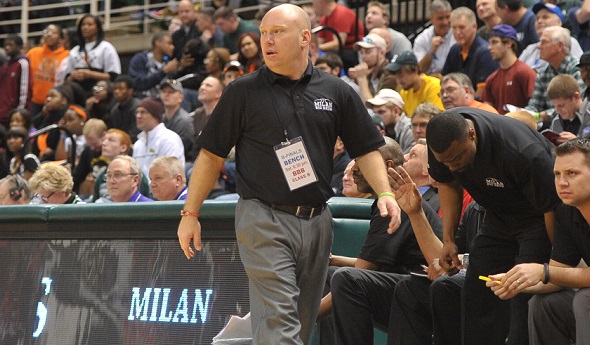
Chelsea Coach Back 'To See This Through'
October 26, 2018
By Doug Donnelly
Special for Second Half
CHELSEA – Is anyone more excited about the start of prep basketball season than Josh Tropea?
With the calendar turning to November soon, we are only days away from the first boys basketball practice of the 2018-19 season. One of the biggest hardwood stories in southeast Michigan is that Tropea is back at Chelsea High School for his second stint as the head varsity coach there.
 He wasn’t gone long – he stepped away for just two years to coach at Spring Arbor University – but Tropea has brought his high energy and passion for basketball, and his whole family, back to the high school ranks.
He wasn’t gone long – he stepped away for just two years to coach at Spring Arbor University – but Tropea has brought his high energy and passion for basketball, and his whole family, back to the high school ranks.
“I’m thrilled to be back,” Tropea said. “I love being in a packed gymnasium on a Friday night. I’m so looking forward to battles with Dexter and playing Ypsilanti and going on the road for games. I love it.”
Tropea said he stepped away from the college job for several reasons – including the time he was spending away from his family on the weekends and because the timing was right to come back. Mark Moundros resigned after two years when he moved from the area. Tropea said he wanted to ensure the program continued its upward path.
“I have two sons at Chelsea,” he said. “If Mark had stayed I would not be here. But, when Mark left, and they didn’t have a viable candidate at the time, I felt like I didn’t want to let my two years here, the two years I had invested before leaving, to fall apart. Mark did a great job. I’d love it if he stayed, but I felt like I owed it to the kids to come back and see this through.”
The college experience has changed his approach to the game.
“I loved my college experience – loved it. Absolutely no regrets,” Tropea said. “But, I tell you, they have a much better version of me now. My temperament is better. I think I see the bigger picture better. Spring Arbor is all about being the best person you can be. I think I’m better now, not just in the Xs and Os, but as a person, as a coach.”
Tropea was already pretty good.
A South Lyon native, he’s been a basketball junkie for years. He got his first high school coaching job at Walled Lake Western while still in college. He made stops at Whitmore Lake and Howell while looking for a permanent teaching job, then landed at Milan in what turned out to be a made-for-each-other job. In short time, he rejuvenated the Milan Big Reds program from two wins the season before he took over the varsity to a surprise run to the Class B championship in 2013-14.
It wasn’t so much of a surprise that the Big Reds won the title that season, but how quickly Tropea built them into a powerhouse. During the summer before the title run, Tropea had his troops playing games all over the state, lining up scrimmages and playing in shootouts and tournaments that exposed the Milan players to some of the other elite.
“We had a lot of kids come from struggling homes or from tough situations,” Tropea said of his time at Milan. “Those kids were not entitled kids. As a family, we were able to make an impact in so many ways. Team dinners were a big deal. That’s what made leaving Milan so hard.
“It was maybe the best five years of my life for my wife and I,” he added. “It was such an exciting time, and we were just so embraced by the community.”
During his time there, the Big Reds went 92-27 and won three Huron League titles. The Class B title run was led by future college players Nick Perkins and Latin Davis. The Big Reds’ state championship was the first in boys basketball in the Monroe County Region in more than 60 years.
Tropea left Milan, he said, because of the teaching and coaching opportunity in Chelsea. Frankly, he said, the job paid more, and, for a young family, that was a big deal.
“It was a very difficult decision, but it was right for my family,” he said. “I was on a pay freeze for five straight years at Milan. Plus, we loved the Chelsea community. My wife wanted to come here.”
Although he was there just two seasons, Chelsea’s basketball program also came a long way in a short time.
The Bulldogs improved from 3-18 the year before he was there to 9-13 in 2014-15 and 16-6 in 2015-16, tying for second place in the Southeastern Conference White his second season. More importantly, Tropea laid the groundwork for the future. He started by getting into the lower levels of the school and teaching basketball to the younger students – and trying to let his passion for the game pass on to them.
“It’s rolling now,” he said. “The first year I had a summer camp, we had 17 kids. This past summer, we had 121. Everybody knows you have to have a youth program.
“We won 16 games my last year here, we won a District title two years ago and the team went 12-8 last year,” he said. “The program is in great shape.”
Tropea never has been afraid to adapt his game or the way he interacts with his players. He draws on his experiences working with other coaches every chance he gets.
“The game is constantly changing, and so are the kids,” he said. “You have to. You have to change.”
In today’s world that means using social media, such as Twitter, to set the tone of the program.
The @ChelseaBoysHoop Twitter feed, for example, regularly includes messages about workouts, inspirational quotes from some of game’s great players and encouragement to other Bulldogs athletes.
Great turnout at the meeting this morning! #BringtheJuice #GreaterThan #WePlayForMarch pic.twitter.com/ePCMjmAJdU
— ChelseaBoysHoop (@ChelseaBoysHoop) October 23, 2018
“I feel it can be a great tool if it is done right and positive,” he said of Twitter.
His wife, Alicia, is an integral part of the program, as are his children, Luke and Zack.
“This is definitely a family deal,” he said. “We are all in. I know no matter what, my wife will be in the third row and she’s so supportive. She’s all-in all the time. She supports me and my passion. You have to have that.”
Years from now, he said he might get back into the college game. But for now, being back at the high school level fits more his love of teaching the game.
“I’m a teacher at heart,” he said. “I love teaching the game. I love the four-player workouts and teaching the kids footwork and the importance of passing the ball with the seam. That’s what it’s all about – making an impact on the kids’ lives.”
The SEC can be a brutally tough league, and this year it’s only going to be stronger with the addition of Jackson to the division. With boys basketball season starting a week earlier this year and Chelsea’s football team alive in the MHSAA Playoffs, Tropea is employing somewhat of a different strategy than normal. The emphasis on the season, he said, will be to get his team ready for the Class B tournament come late February. He doesn’t want the players to peak too soon.
“We have one game before December 15,” he said. “We back-loaded the heck out of our schedule. I don’t care how good we are in November and December. I want to be playing our best basketball in March. We’re playing for March.”
Chelsea will have seven or eight seniors and five or six juniors on this year’s squad, Tropea said. Many of those seniors were part of a group that went 20-0 as freshmen and won 16 games as sophomores.
“We have some experience, and not just athletes but basketball players,” he said. “They are leaders. I’m so excited for this season. I’m happy to be back.”
 Doug Donnelly has served as a sports and news reporter and city editor over 25 years, writing for the Daily Chief-Union in Upper Sandusky, Ohio from 1992-1995, the Monroe Evening News from 1995-2012 and the Adrian Daily Telegram since 2013. He's also written a book on high school basketball in Monroe County and compiles record books for various schools in southeast Michigan. E-mail him at [email protected] with story ideas for Jackson, Washtenaw, Hillsdale, Lenawee and Monroe counties.
Doug Donnelly has served as a sports and news reporter and city editor over 25 years, writing for the Daily Chief-Union in Upper Sandusky, Ohio from 1992-1995, the Monroe Evening News from 1995-2012 and the Adrian Daily Telegram since 2013. He's also written a book on high school basketball in Monroe County and compiles record books for various schools in southeast Michigan. E-mail him at [email protected] with story ideas for Jackson, Washtenaw, Hillsdale, Lenawee and Monroe counties.
PHOTO: Returning Chelsea boys basketball coach leads his Milan team to the Class B championship in 2014 at Breslin Center.
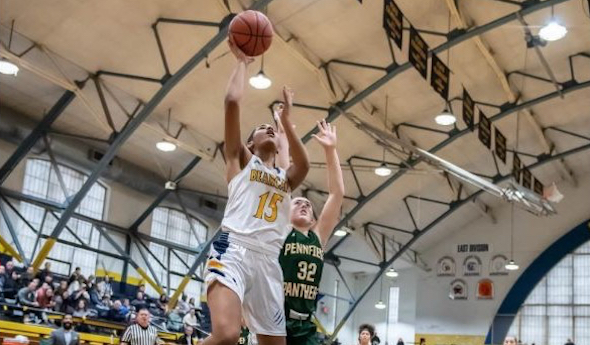
Hoops Finds Annual Home During Holidays
December 27, 2019
By Ron Pesch
Special for Second Half
Nothing says the Holidays like a high school basketball tournament.
It started, like many things do, with a drip. Well, make that a dribble.
The Michigan High School Athletic Association has allowed Holiday basketball tournaments for years. When was the first? That’s hard to establish. No one really kept track of such. A 1934 Wakefield News article indicates that a “Christmas Tournament will be held for the (Gogebic) Range teams at Wakefield December 27 and at Ironwood December 28.” Hurley, Bessemer, Ironwood and Wakefield were entered in the “blind” tournament, with opponents drawn just before game time. It was a new idea, at least in the Upper Peninsula.
“Nothing of its kind has ever been attempted in the Peninsula before,” stated the Ironwood Daily Globe. The tournament, won by Hurley, was a financial success. After expenditures, including the purchase of trophies, profit equaled enough that $22.42 was distributed to each school competing in the tournament. Plans were announced to bring back the tournament in a larger format the following year. It did return the following December, with the same teams in the same format but with all games played in Wakefield. This time out, Ironwood topped Hurley 22-21 for the tournament title.
In the Lower Peninsula in 1935, an All-Berrien County Holiday tournament was held Dec. 26, 27 and 28, with Three Oaks winning the Class B-C division title, 15-13 in the final over Berrien Springs. St. Joseph Catholic emerged as the Class D victor with a surprising 27-26 win over the reigning MHSAA state champ from Stevensville. The 14-team competition was played at Niles High School. Attendance was “slim, very slim” for the opening day of the tourney. The event did not return in 1936.
A similar, but much smaller, event was staged in Berrien County in 1941 with the Bridgman Class C Invitational. The tournament featured seven teams with contests spread over three nights. It was a success.
“Some 450 paid admissions were checked in Wednesday night for the championship finals, which Bridgman won from Berrien Springs. … The total paid admission for the three night event was 1,420 fans with a gross gate of approximately $400.”
By the mid-1940s, the idea of playing prep basketball during the Christmas lull had begun to take off across the state.
In December 1946, before a crowd of 1,500 at the Flint IMA Auditorium, Holland, the reigning Class A champion, downed Flint Northern 51-48 behind a pair of late field goals by Ken ‘Fuzz’ Bauman in the first annual Motor City Invitational. In Jackson, Detroit Catholic Central won the Michigan Catholic Invitational, beating Kalamazoo St. Augustine, 42-40. Bridgman again snagged the title at the Sixth Annual Berrien Class C Christmas Holiday Tournament. It was the Bees’ third Christmas championship in four years. The Little Eight Conference Holiday Tournament was played across four school gymnasiums as the calendar transitioned from 1946 to 1947. Bangor downed Covert, 34-29, in the championship contest hosted at Watervliet High School on Saturday, Jan. 4.
“Holiday tournament basketball has really caught on in Michigan,” said Hal Schram in the Detroit Free Press in 1947. “There will be no Christmas-New Year’s rest for at least 60 Michigan high school squads which have jumped at the chance to sharpen their collective shooting eyes for the long season ahead. … At last count, tournaments will be played between Dec 17 and Jan 3 at Flint, Saginaw, Grand Rapids, Jackson, Lincoln Park, Fremont, Negaunee, Marquette, Benton Harbor and Detroit.”
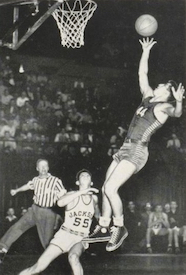 The same eight schools that played at the first Motor City tournament – Jackson, Grand Rapids Central, Holland, Muskegon Heights, Monroe, Midland, Flint Central and Flint Northern – were invited back for the second year. According to Schram, “Not a single participating school of a year ago wanted to be left out.”
The same eight schools that played at the first Motor City tournament – Jackson, Grand Rapids Central, Holland, Muskegon Heights, Monroe, Midland, Flint Central and Flint Northern – were invited back for the second year. According to Schram, “Not a single participating school of a year ago wanted to be left out.”
Jackson downed Flint Northern in the title game, 39-34.
The Saginaw Invitational, hosted at Arthur Hill High School, boasted six Class A schools as well as Alma and Mount Pleasant, both Class B schools. Mount Pleasant surprised the field, winning the tournament with a 40-25 triumph over Dearborn Fordson in the championship game.
A year later in December, Schram wrote, “The Michigan High School Athletic Association wasn’t caught unaware when the tournament bug started to bite every sector of the state.”
“Never did we expect such a wave of tournament play as we will see during the next three weeks,” said Charles Forsythe, state director for the MHSAA, noting 34 Christmas vacation tournaments were scheduled between December 15 and January 8 during the 1948-49 basketball season. “Perhaps we’re lucky at that. The Oklahoma association has had to sanction 123 tournaments.”
Forsythe and Schram explained the reasons for the wave of popularity. Of particular interest was the fact that, at the time, a school sponsoring both football and basketball could play a total of no more than 24 games, combined, in the two sports. However, MHSAA rules allowed a basketball team the chance to play as many as three games during a Holiday tournament and be charged with only one of its allotted combination of 24 contests. (The MHSAA rules changed prior to 1972-73 to allow basketball teams a maximum of 20 games.)
Coaches could keep their squads sharp during the two-week layoff with games rather than just mandatory practices. And, as a bonus to all because tournaments were financed through gate admissions, invitations to larger tournaments meant teams got to “stay and eat at the best hostelries, go on sightseeing tours when not playing and play non-conference opponents from other sections of the state.“
Add in the chance to play before larger-than-normal crowds, and the formula for a successful tournament was cast.
Beginning with the 1950-51 season, the football-basketball rule was altered to count play in mid-season invitational tournaments as two contests. With the change, according to the Detroit Times, “the number of such meets dropped sharply.”
Only nine Holiday tournaments, involving 50-plus teams, were recorded by the MHSAA during the 1951-52 season: the 5th annual Flint Parochial Invitational, the Alpena Catholic Invitational (involving 16 teams), the 5th Annual Greater Lansing Invitational, the Albion College Invitational, the Twin-Five Conference Christmas Tournament (a 10-team replacement for the disbanded Little Eight Conference’s tournament), the Otisville Invitational, the Columbiaville Invitational and the 1st Annual Portland St. Patrick Christmas Invitational.
But by the 1960s, Holiday Tournaments were again regaining popularity, with more now focused on teams from a specific community or section of the state, especially among smaller schools.
The St. Patrick tournament was still going strong in 1966 – its 15th year – with an eight-team, four-day design. Williamston downed a Cinderella squad from Carson City, 64-44, before 1,100 fans at Portland to earn the championship. Other Mid-Michigan holiday tournaments played out in Chelsea and Swartz Creek at the same time.
The Flint Parochial League Tournament was a mainstay of the Holiday season until the breakup of the league in the early 1970s.
“Basketball tournaments have become popular around the state and nation in recent years,” wrote Wendy Foltz, longtime Battle Creek Enquirer sports editor, before the kickoff of the inaugural Battle Creek Central Holiday Cage Tournament in 1968. In a twist that harkened back to earlier days, the eight-team event represented nearly every section of lower Michigan. “Battle Creek never has been a rabid basketball town like some around the state,” added a hesitant Foltz, noting a hope that the event could at least break even.
Hosted at the Cereal City’s historic Fieldhouse, built in 1928, that first tournament was won by host Battle Creek Central, which downed Traverse City 71-53 before a crowd of 2,000. Phil Todd led the Bearcats with 29 points, including 21 in the first half, while 6-foot-8 Tom Kozelko paced TC with 24. Muskegon Heights won the consolation game, holding off a late Ypsilanti Willow Run rally, 78-77. Other schools competing were Battle Creek Lakeview, Grand Blanc, Romulus and recently-opened Jackson Lumen Christi.
Chuck Turner, Central’s head coach, and junior varsity coach Jack Schils had contacted 60 schools during the summer of 1967 to organize the 12-game schedule.
“The response was terrific,” said Schils, who added, “Many schools could not accept because of schedule commitments but want to enter a year hence.”
The Battle Creek tournament was back in 1969, again hosting teams from near and far. Schils noted that cost ran high when teams were brought in from long distances: “However, this type of tournament is highly desirable so we hope fans will support it.”
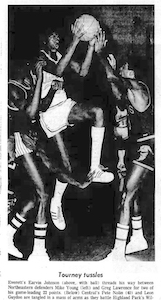
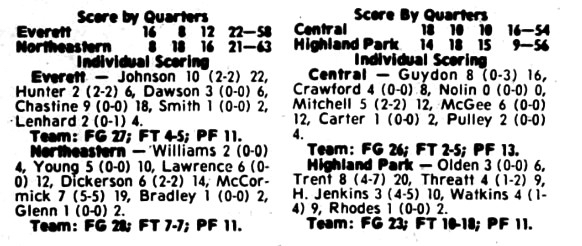 But the event was discontinued following the 1970-71 season when the “eight team format became too unwieldy,” according to the Enquirer “… and both crowd and the quality of play declined.”
But the event was discontinued following the 1970-71 season when the “eight team format became too unwieldy,” according to the Enquirer “… and both crowd and the quality of play declined.”
Pared down to a four-team format, it returned in a big way in December 1975. The tournament saw standing-room-only crowds of more than 3,000 for games between Battle Creek Central, Detroit Northeastern, Class A quarterfinalist Lansing Everett and reigning Class A champion Highland Park.
Detroit Northeastern downed Lansing Everett, 63-58 for the Cereal City championship trophy. Everett junior Earvin Johnson scored 22 points and, with teammate Reggie Chastine, was named to the all-tournament team along with Northwestern’s Wilbert McCormick, the tourney MVP, and his teammate Greg Lawrence. Highland Park’s William Trent and Battle Creek Central’s Leon Guydon also were named to the team.
By the 1980s, it seemed that the Christmas break nearly mimicked March in Michigan.
“I think a Christmas tournament really helps your program,” said Turner in 1980 to the Enquirer. He had taken over the head coaching position at Battle Creek in the fall of 1967 after a successful stint at Willow Run. “I don’t understand basketball teams having a preseason, playing three or four games, then taking two weeks off. When you get back, it’s like starting over.”
Besides Turner’s squad, the 1980 field included Detroit Western, Detroit Murray Wright and eventual winner Kalamazoo Central. The event would ultimately be re-christened the Battle Creek Central Chuck Turner Holiday Classic.
“The late Chuck Turner started bringing big games to the city over the holidays when he first started at the school in the 1960s,” wrote Bill Broderick in the Enquirer in 2018.
“Chuck started this because he wanted to give people the chance to come back home for the holidays and see everyone play. It’s been like a family reunion over the years,” Fred Jones told Broderick. Jones was a longtime assistant to Turner. “That we can keep it going in his name is great and hopefully we can keep if going for another 50 years.”
The girls are now part of the action. All five Battle Creek city schools – Central, Pennfield, Harper Creek, Lakeview, and St. Philip – were part of the event in 2018.
This year the Chuck Turner Central Field House Holiday Classic will again span two days – December 27 and 28 – and will again see all five city schools play on the historic floor.
Other Holiday tournaments scheduled this year include:
Petoskey Invitational – December 13-14
Raider Shootout – December 21
18th Annual Muskegon Area Sports Hall of Fame Classic – December 27
Earl McKee Classic – December 27-28
North Farmington Holiday Extravaganza – December 27
Motor City Roundball Classic – December 27
Cornerstone Invitational – December 27
Washtenaw Hoops Showcase – December 28
 Ron Pesch has taken an active role in researching the history of MHSAA events since 1985 and began writing for MHSAA Finals programs in 1986, adding additional features and "flashbacks" in 1992. He inherited the title of MHSAA historian from the late Dick Kishpaugh following the 1993-94 school year, and resides in Muskegon. Contact him at [email protected] with ideas for historical articles.
Ron Pesch has taken an active role in researching the history of MHSAA events since 1985 and began writing for MHSAA Finals programs in 1986, adding additional features and "flashbacks" in 1992. He inherited the title of MHSAA historian from the late Dick Kishpaugh following the 1993-94 school year, and resides in Muskegon. Contact him at [email protected] with ideas for historical articles.
PHOTOS: (Top) The Battle Creek Central and Pennfield girls face off during the 50th Chuck Turner Classic. (Middle) Shaheen Shaheen scores two points for Flint Northern, which fell to Jackson 39-34 during the 1947 Motor City championship game. (Below left) Lansing Everett’s Earvin Johnson makes a move toward the basket against Detroit Northeastern during the 1975 Battle Creek event. (Below right) Box scores from the 1975 tournament include Johnson’s 22 points in the 63-58 loss. Photos courtesy of the Battle Creek Enquirer, Lansing State Journal and Ron Pesch archives.)

